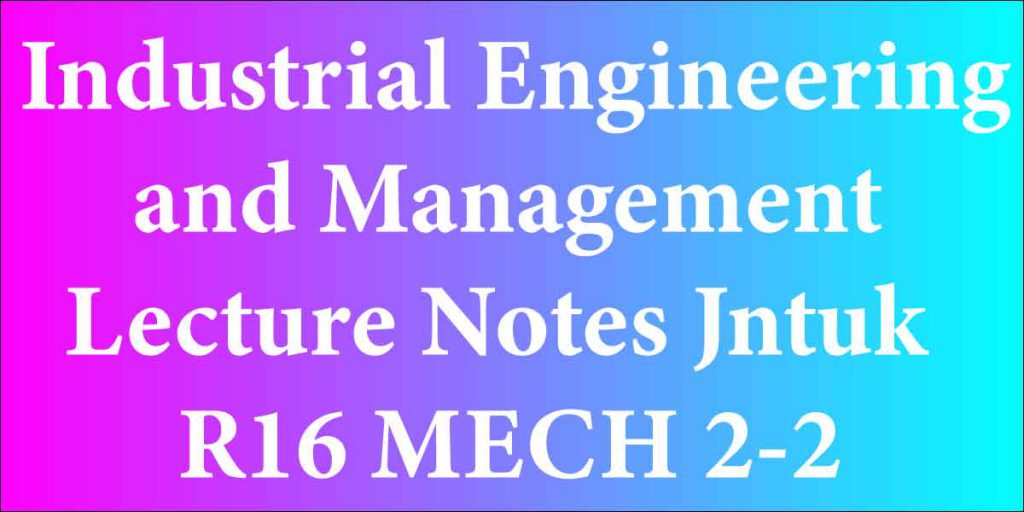Industrial Engineering and Management
Course Objectives:
- To impart elementary data and ability sets needed within the engineering science and Engineering profession, that embody the power to use basic data of arithmetic, likelihood and statistics, and therefore the domain data of commercial Management and Engineering
- To provide graduates with the power to adopt a system approach to style, develop, implement and introduce integrated systems that embody folks, materials, info, instrumentality and energy.
- To alter students to grasp the interactions between engineering, business, technological and environmental spheres within the trendy society.
- To alter students to grasp their role as engineers and their impact to society at the national and world context.
UNIT – I
INTRODUCTION: Definition of commercial engineering (I.E), development, applications, role of associate industrial engineer, variations between production management and technology, quantitative tools of that is and productivity mensuration. ideas of management, importance, functions of management, scientific management, Taylor’s principles, theory X and theory Y, Fayol’s principles of management.
UNIT – II
PLANT LAYOUT: Factors governing plant location, forms of production layouts, blessings and downsides of method layout and merchandise layout, applications, quantitative techniques for optimum style of layouts, plant maintenance, preventive and breakdown maintenance.
UNIT – III
OPERATIONS MANAGEMENT: Importance, forms of production, applications, workstudy, methodology study and examination, work sampling, PMTS, micro-motion study, rating techniques, MTM, work issue system, principles of engineering, flow method charts, string diagrams and Therbligs,
UNIT – IV
applied math QUALITY CONTROL: internal control, its importance, SQC, attribute sampling review with single and double sampling, management charts – X and R – charts X AND S charts and their applications, numerical examples.
TOTAL QUALITY MANAGEMENT: zero defect construct, quality circles, implementation, applications, ISO quality systems. six letter of the alphabet – definition, basic ideas
UNIT – V
RESOURCE MANAGEMENT: construct of human resource management, personnel management and industrial relations, functions of personnel management, Job-evaluation, its importance and kinds, benefit rating, quantitative ways, wage incentive plans, types.
II Year – II Semester
L T P C
4 0 0 3
INDUSTRIAL ENGINEERING AND MANAGEMENT
UNIT – VI
worth ANALYSIS: worth engineering, implementation procedure, enterprise resource designing and provide chain management. PROJECT MANAGEMENT: saucy, CPM – variations & applications, essential path, determination of floats, importance, project flaming, smoothing and numerical examples.
TEXT BOOKS:
- technology and management / O.P Khanna/Khanna Publishers. 2. technology and Production Management/Martand Telsang/S.Chand & Company Ltd. New Delhi Reference Books:
- engineering science / Bhattacharya DK/Vikas publishers a pair of. Operations Management / J.G Monks/McGrawHill Publishers. 3. technology and Management Science/ T. R. Banga, S. C. Sharma, N. K. Agarwal/Khanna Publishers four. Principles of Management /Koontz O’ Donnel/McGraw Hill Publishers. 5. applied math internal control /Gupta/Khanna Publishers half-dozen. technology and Management /NVS Raju/Cengage Publishers
Course outcome:
Upon self-made completion of this course you ought to be in a position to: - style and conduct experiments, analyse, interpret information and synthesize valid conclusions
- style a system, component, or process, and synthesize solutions to realize desired wants
- Use the techniques, skills, and trendy engineering tools necessary for engineering follow with acceptable concerns for public health and safety, cultural, societal, and environmental constraints
- operate effectively at intervals multi-disciplinary groups and perceive the elemental precepts of effective project management

